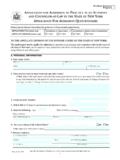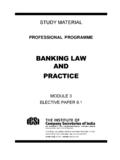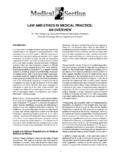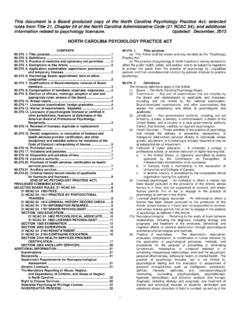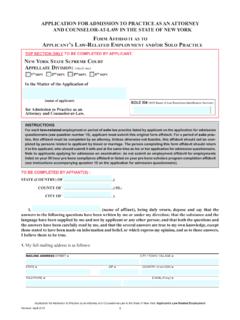Transcription of DTIC
1 Q ' Lanchester's Square Law in Theory and Practice0 LnA MonographbyMajor Ronald L. JohnsonCorps of EngineersDTIC&%ELECTEAUG2 11990A4 AIS V ITO RSchool of Advanced Military StudiesUnited States Army Command and General Staff CollegeFort Leavenworth, Kansas~First Term AY 89/90 Approved for Public Release; Distribution is Unlimited-390-3176 UNCLASSIFIED9 CURITY CLASSIFICATION OF THIS PAGER R DForm ApprovedREPORT DOCUMENTATION PAGE OMB No. REPORT SECURITY CLASSIFICATION lb. RESTRICTIVE MARKINGSU nclassifiedha. SECURITY CLASSIFICATION AUTHORITY 3. DISTRIBUTION /AVAILABILITY OF REPORTA pproved for public release;2b. DECLASSIFICATION/ DOWNGRADING SCHEDULE distribution is unlimited4 PERFORMING ORGANIZATION REPORT NUMBER(S) 5.
2 MONITORING ORGANIZATION REPORT NUMBER(S)6. NAME OF PERFORMING ORGANIZATION 16b. OFFICE SYMBOL 7a. NAME OF MONITORING ORGANIZATIONS chool of Advanced Mility (If applicable)Studies, USA C&GSC IATZL-SWVk. ADDRESS (City, State, and ZIP Code) 7b. ADDRESS (City, State, and ZIP Code)Fort Leavenworth, Kansas66027-6900ta. NAME OF FUNDING/SPONSORING 8lb. OFFICE SYMBOL 9. PROCUREMENT INSTRUMENT IDENTIFICATION NUMBERORGANIZATION (If applicable)k. ADDRESS (City, State, and ZIP Code) 10. SOURCE OF FUNDING NUMBERSPROGRAM IPROJECT ITASK IWORK UNITELEMENT NO. NO. NO. ACCESSION TITLE (Include Security Classification)Lanchester's Square Law in Theory and Practice(//)2. PERSONAL AUTHOR(S)MAJ Ronald L.
3 Johnson, USA13a. TYPE OF REFORT jl3b. TIME COVERED 14. DATE OF REPORT (Year, Month, Day) 115. PAGE COUNTM onograph FROM TO 17 89/11/27 7 -5016. SUPPLEMENTARY NOTATION17. COSATI CODES 18. SUBJECT TERMS (Continue on reverse if necessary and identify by block number)FIELD GROUP SUB-GROUP National- Training Centef-I I Lanchester' s Equations, T]'ff 4..Suppression,-} I1 19. ABSTRACT (Continue on reverse if necessary and identify by block number)his monograph conducts a tatistical analysis of the National Training Centeiengagement data to determine to what extent that training adheres to thesquare law. The monograph discusses the theory of the square law, summarizesthe findings of previous verification attempts, discusses the National Train-ing Center as a laboratory for this analysis, presents the results of thestatistical analysis and suggests that an exponential law is more appro-priate.
4 A discussion follows centered around the reason for this gap betweentheory and practice. The monograph discusses the problem of suppression as thmissing link in the square law. The conclusion drawn is that whenever combatsimulations are used, those simulations should account for the problem ofsuppression or else the results will be distorted. Furthermore, it appearsthat if combat follows an exponential law then the National Training Centertraining may come closer to combat than the US Army thinks. (';20 DISTRIBUTION/AVAILABILITY OF ABSTRACT 21. ABSTRACT SECURITY CLASSIFICATIONCUNCLASSIFIED/UNLIMITED 0 SAME AS RPT. 0 OTIC USERS Unclassified22s. NAME OF RESPONSIBLE INDIVIDUAL 22b TELEPHONE (include Area Code) 22c.)
5 OFFICE SYMBOLMAJ Ronald L. Johnson (9131_684-33 I ATZL-SWV00 Form 1473, JUN 86 Previous editions are obsolete. SECURITY CLASSIFICATION OF THIS PAGESCHOOL OF ADVANCED MILITARY STUDIESMONOGRAPH APPROVALM ajor Ronald L. JohnsonTitle of Monograph: Lanchester's Square Law in Theory andPracticeApproved by:P*O Monograph Directores J. 91hneider, MA Mngah rcoDirector, School ofColonel William H. MA, MMAS Advanced MilitaryStudies_____e____ Director, GraduatePhii J rookes, Degree ProgramAccepted this #2614_ day of _ __ __ 1990-- -m mmm mmmmmmm m mmmlmmlm m mm m rlm ..ABSTRACTLANCHESTER'S SQUARE LAW IN THEORY AND PRACTICE by^Ronald L. Johnson, USA, 50 analysts have employed simple mathematicalmodels to obtain insights into the dynamics of arried combatat least since 1914.)
6 In that same year, Frederick WilliamLanchester proposed his own model of combat dynamics toillustrate the principle of concentration. Lanchester's famoussquare law states that the casualty ratio should vary inversely,as the force ratio. Hence a force which could concentrate toachieve the "proper" force ratio could inflict a certain amountof casualties on another analyses using historical data have beenconducted. Attempts to verify Lanchester's square law usinghistorical data have had mixed results. In most cases, theLanchester square law has not stood up to empirical scrutinyand an exponential law has appeared as being moreappropriate. Even though attempts at validation haverepeatedly failed, the modelling communtiy continues to relyupon the model as a base for other monograph conducts a statistical analysis of theNational Training Center engagement data to determine towhat extent that training adheres to the square law.
7 Themonograph discusses the theory of the square law, summarizesthe findings of previous verification attempts, discusses theNational Traing Center as the laboratory for this analysis,presents the results of the statistical analysis and suggests thatan exponential law is more appropriateA discussion follows centered around the reason for thisgap between theory and practice. This monograph discusses thEproblems of suppression and fire control as missing links in thesquare law. The monograph concludes with a proposal thatwhenever combat simulations are used, they should accountfor the problem of suppression or else the results will bedistorted. Furthermore it appears that if combat follows anexponential law then the NTC may come closer to combat thanthe US Army of ContentsI.
8 In t r o d u c tio n .. 1II. The Square Law and Its Theory .. 5I1. History and the Application of the Theory of theS q u a re L a w ..11IV. The National Training Center as a Data Source .. 22V. Statistical Analysis of National Training Center Data ..26VI. The Problems of Suppression and Fire Control .. 30V II. Conclusions and Im plications .. 41 VIII. Appendix A. NTC Data Worksheets .. 43IX. Bibliography .. 48 NTIS CRA&ID1C TAB 0J _,I If tic3 ),. I '0I ) 117 dtSAvL~ C ij I orOi~l Soc IntroductionTheory will have fulfilled its main task when it is usedto analyze the constituent elements of war, to distinguishprecisely what at first sight seems fused, to explain infull the properties of the means employed and to showtheir probable effects, to define clearly the nature of theends in view and to illuminate all phases of warfare in athorough critical inquiry.
9 Theory then becomes a guide ..to learn about IThis passage from Clausewitz expresses the essential roleof modelling combat. Military analysts have employed simplemathematical models to obtain insights into the dynamcs ofarmed combat at least since The model which serves asthe standard for others is the one which was proposed byFrederick William Lanchester in 1914. During World War 1,Lanchester's original work received little attention. DuringWorld War II, the Army Air Corps gave some considerationto Lanchester's model, however this consideration had nooperational impact. Without capabilities to solve morecomplicated models, Lanchester's model tended to beuniversally accepted.
10 His models lent themselves to ease Carl von Clausewltz, On War, trans. by Michael Howard and PeterParet, (Princeton, NJ: University of Princeton Press, 1976), p Stephen P. Stuk, "Multivariable Systems Theory for LanchesterType Models", Dissertation Georgia Institute of Technology, 1987, p the invention of the digital computer, whole newgenerations of Lanchester-type differential equation modelswere developed. These models were developed becauseLanchester's model fell short in its ability to capture the manyunquantifiable aspects of combat. Even today these modelsprovide the mathematical foundations for analyticalinvestigations and serve as the primary basis for calculatingcombat attrition in large scale computer utility of these models to military operators andplanners in modelling combat attrition is great.










